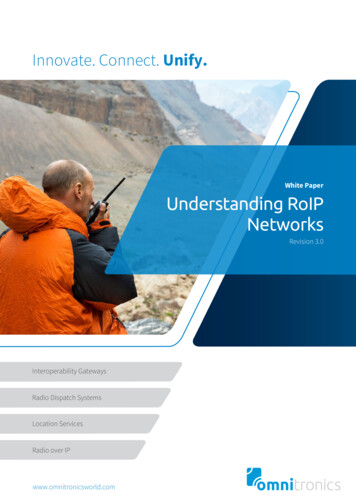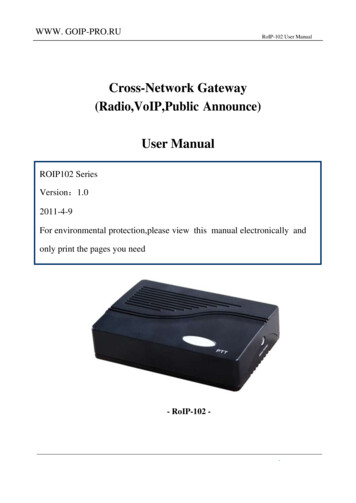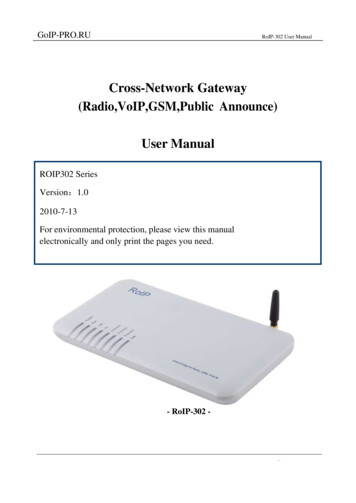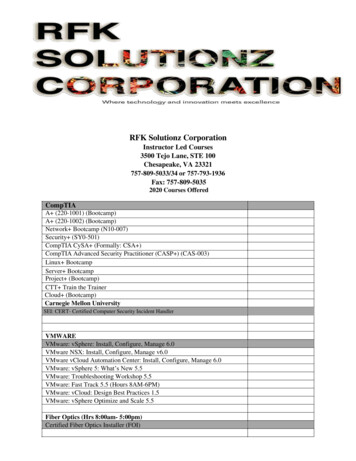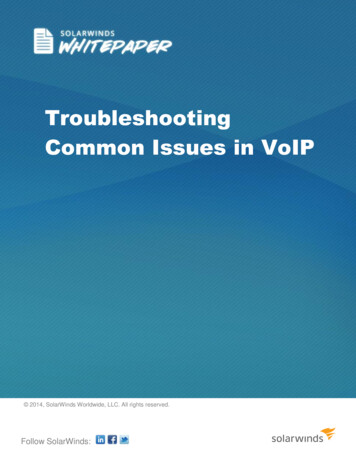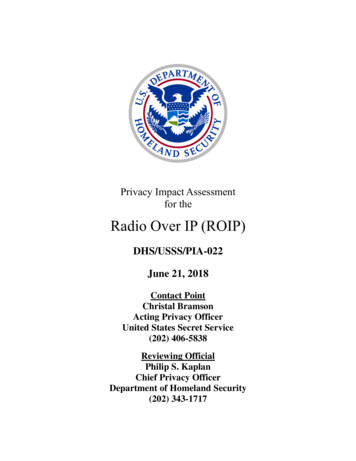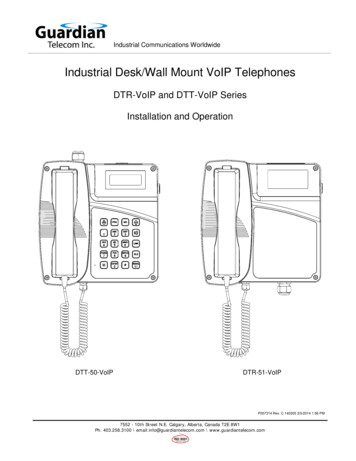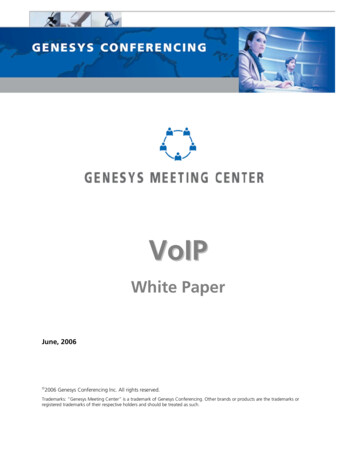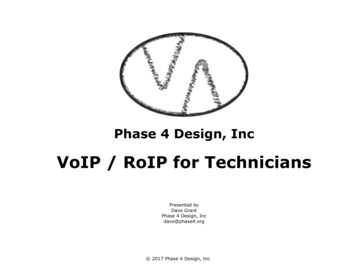
Transcription
Phase 4 Design, IncVoIP / RoIP for TechniciansPresented byDave GrantPhase 4 Design, Incdave@phase4.org 2017 Phase 4 Design, Inc
VoIP / RoIP for TechniciansNotes2 2017, Phase 4 Design, Inc.
VoIP / RoIP for TechniciansTable of ContentsWhat are we going to discuss today . 5About Us . 6About You . 8Basic Premise . 93 2017, Phase 4 Design, Inc.
VoIP / RoIP for TechniciansTable of FiguresFigure 1 Featured in MissionCritical Communications Magazine . 7Figure 2 Multicast MAC Creation .22Figure 3 RoIP System using VPN .244 2017, Phase 4 Design, Inc.
VoIP / RoIP for TechniciansWhat are we going to discuss todayTopic for today / AgendaCover the aspects of VoIP vs RoIPExamine Potential SolutionsCover the aspects of the VoIP / RoIP Network InterfaceDiscuss Network Requirements for RoIP5 2017, Phase 4 Design, Inc.
VoIP / RoIP for TechniciansAbout UsDave Grant – Instructor / dave@phase4.orgMike Grant – Producer – Student Coordinator / mike@phase4.orgPhase 4 Design, Inc. has been serving the telecommunicationsindustry since 1990. We are located in the Pacific Northwest and weserve customers all across the US. Dave started working in 2-WayRadio in 1972.In 2009-2010 we retooled the company to focus on custom Telex RoIPintegration, training and support, including SIP Phone Systems.Since then we have developed online training classes for Telex RoIPand Basic 2-Way Radio. These classes are live and interactive withmultiple HD cameras during online labs. Mike joined us in mid-2016 asthe online class Producer and Student Coordinator.6 2017, Phase 4 Design, Inc.
VoIP / RoIP for TechniciansIn 2016 our work with the Washington State Department of Fish andWildlife was a feature article in MissionCritical CommunicationsMagazine, November/December 2016 issue.Figure 1 Featured in MissionCritical Communications Magazine7 2017, Phase 4 Design, Inc.
VoIP / RoIP for TechniciansAbout YouRadio ExperienceAnyone have RoIP Experience?Anyone have IT Experience?Anyone have an example system to use?What do you want to get from this session?8 2017, Phase 4 Design, Inc.
VoIP / RoIP for TechniciansBasic PremiseWhat is the difference between a VoIP and a RoIP System?How do we interface our RoIP or VoIP System to the network?9 2017, Phase 4 Design, Inc.
VoIP / RoIP for TechniciansVoIP1 v RoIP2VoIP Mission Standards 12Provide for the delivery of Voice Calls via IP NetworksProvide support of Advanced PSTN and Mobile FeaturesProvide PTT services to Land Mobile Radio via IP NetworksVonage, Comcast, IMS, Skype, Cisco, Avtec, ZetronVoIP - Voice over Internet ProtocolRoIP - Radio over Internet Protocol10 2017, Phase 4 Design, Inc.
VoIP / RoIP for Technicians Protocols Session Initiation Protocol (SIP) RFC 3261 H.323v2 (International Telecommunications Union)RTP (Real Time Protocol)Internet Group Management Protocol Version 3Multicast Listener Discovery Protocol Version 2 (MLDv2) for Source-Specific MulticastMulticast VoIPDifferentiated Services Code Point (DSCP)Project 25 Console Subsystem Interface (P25 CSSI)Project 25 Inter Subsystem Interface (P-25 ISSI)Vendor Specific Proprietary Protocols Architecture 11Session BasedRequires Server or End-Point NegotiationServer exposes a Single Point of Failure 2017, Phase 4 Design, Inc.
VoIP / RoIP for TechniciansRoIP Mission Standards 12Provide PTT services to Land Mobile Radio via IP NetworksProvide Enhanced Remote Radio Control via IP NetworksProvide IP equivalent to a 2 Wire or 4 Wire Audio CircuitBridging System Interface (BSI) DraftAPCO P25 DFSITelex Radio Dispatch Proprietary SystemMindshare Radio Dispatch Proprietary System 2017, Phase 4 Design, Inc.
VoIP / RoIP for Technicians Protocols Architecture 13RTP (Real Time Protocol)MulticastInternet Group Management Protocol Version 2Differentiated Services Code Point (DSCP)Project 25 Console Subsystem Interface (P25 CSSI)Project 25 Inter Subsystem Interface (P-25 ISSI)Project 25 Digital Fixed Station Interface (P-25 DFSI)Vendor Specific Proprietary ProtocolsStream BasedStatic Mapping of End-PointsNo Single Point of Failure 2017, Phase 4 Design, Inc.
VoIP / RoIP for TechniciansEthernet Network EssentialsOpen Systems Interconnection ModelLine Standards on the Wire Bitrate / Timing Voltage levels Cable loss PinoutsEthernet Speeds, data types Protocol overhead Broadcast Multicast MAC Address Hexadecimal numbersBasis for LAN, WAN, Internet definitionsOSI v TCP/IP Model The function is identical The TCP/IP model combines OSI layers 1 and 2 into the Network Layer The TCP/IP model combines OSI layers 3 and 4 into the IP Layer14 2017, Phase 4 Design, Inc.
VoIP / RoIP for TechniciansOpen System Interconnection Model3OSI ess toapplication6.PresentationDatarepresentationand encryption5. SessionInterhostcommunication4. TransportEnd-to-endconnectionsand reliabilityPacket3. NetworkPathdeterminationand logicaladdressingFrame2. Data LinkPhysicaladdressing(MAC & LLC)Bit1. PhysicalMedia, signaland TCP/IP Model shown with colors. Light Green is Network Layer, Light Blue is the Internet (IP) Layer, Dark Blue is theApplication Layer.3Courtesy of Wiki. The TCP/IP Protocol Stack combines Layers 1 & 2 as well as 3 & 4.15 2017, Phase 4 Design, Inc.
VoIP / RoIP for TechniciansProtocolsProtocol Standards for Levels 1 – 7 ARP, IGMP, NAT, DNAT, NTP, SIP, QoS, VPN, DNS, FTP, SSH, DHCP, POP, SMTP, HTTP areexamples of protocols using the OSI ModelWhat do you need to know?Subnet - LAN, WAN, VLAN, etc Logical group of Network Hosts As small as 2 hosts Can be over 16,000,000 hostsEnd to End - Connection vs. Connectionless Setup Time Round-Trips Header size Error tolerancePackage - TCP4, UDP5, Multicast, Packets TCP is guaranteed delivery UDP is catch this if you can Multicast is a special type of UDP Bandwidth is bytes/packet * packets/sec Maximum 15,000pps on 10Mb Ethernet45UDP - User Datagram ProtocolTCP - Transmission Control Protocol16 2017, Phase 4 Design, Inc.
VoIP / RoIP for TechniciansHost LocationLocation - MAC6 Addressing, IP7 Addressing Every NIC has a unique MAC Address (48 bits) Every NIC can have multiple IP Addresses (32 bits) Every IP Address has 65,535 ports each for TCP and UDP There are special ranges of IP Addresses Multicast Addresses 224.0.0.0 – 239.255.255.255 (IP Address begins with 1110) Can be Routed Non-Routable Intranet Address 192.168.0.0- 192.168.255.255 10.0.0.0-10.255.255.255 169.254.x.x APIPA (Automatic Private IP Addressing) Still Routable on the Intranet Everything else is a Routable Internet Address67281,474,976,710,656 possible MAC Addresses4,294,967,296 possible IP Addresses17 2017, Phase 4 Design, Inc.
VoIP / RoIP for TechniciansSubnet Mask Subnet Mask defines the size of the subnet Used to break up a larger Subnet 255.255.255.0 or /24 allows 254 hosts 255.255.255.248 or /29 allows 6 hostsExample11111111111111111111111100000000 255.255.255.0 or /2411111111111111111111111111111000 255.255.255.248 or /2918 2017, Phase 4 Design, Inc.
VoIP / RoIP for TechniciansHost IdentificationUnicast Host Name Resolution (Layer 3) - DNS Maps a URL (Uniform Resource Locator) to an IP Address www.phase4.org 50.194.58.225 IP Address is 32bits One IP Address can have many URL’s www.hostnw.net 50.194.58.225 Depends on a Registrar of Record for Internet Addressing Uses Port 53, for both UDP and TCP transactionsUnicast Subnet Address Resolution (layer 2) - ARP Hard coded into the Ethernet device Unique across the universe Maps an IP Address to a physical Ethernet Card 10.0.1.239 60:6b:9e:a6:ea:17 MAC Address – 48bits One MAC Address can have many IP Addresses Depends on the ARP Protocol to locate a host19 2017, Phase 4 Design, Inc.
VoIP / RoIP for TechniciansPacket RoutingClassful v Classless Network Addressing (layer 3) Class A, Class B, Class C, Class D Class E 240.x.x.x/4 CIDR (Classless Inter Domain Routing) Divides Classful space into smaller address ranges Uses the Netmask to filter packets into subgroups 50.194.58.225/29 netmask 255.255.255.248 A /29 network yields a subnet of 6 host addresses The subnet must be on Network Boundary The subnet will always have a DG and BRDCST Address In effect a /29 network has 4 out of 6 usable host addressesVLAN (Virtual Local Area Network) Generally implemented at Layer 2 Provides a logical grouping of Ethernet MAC Addresses into a separate subnet Requires a managed Layer 2 device to configure VLANUnicast Routing Requires a single Source and Destination IP Address Respects netmask settings Supports routing protocols like RIP, OSPF, etc. Allows for filtering on IP Address, MAC Address, port and packet type Forms the basis for NAT, DNAT, DMZ, Firewall, etc. Allows for packet encapsulation protocols Provides support for QoS protocols like DSCP, port or address marking Does not typically pass Multicast Packets20 2017, Phase 4 Design, Inc.
VoIP / RoIP for TechniciansMulticast Routing Not generally supported in Unicast Routers Introduces the Listener Host MC Branch Addresses maintained by Switch or Router MBone (Multicast Internet Backbone) Internet Gateway Management Protocol (IGMP) Version 2 Version 3 Direct Address MappingA Multicast MAC Address is a combination of an IANA OUI and the Multicast IP Address. (MagicNumber)Multicast Subnet Address Resolution (layer 2) Soft coded into the Ethernet Network device Ignores netmask, MC is only on subnets with MC Listners Unique across the subnet (?) Maps an IP Address to a physical Ethernet Card 239.0.0.5 01:00:5e:00:00:05 224.0.0.5 01:00:5e:00:00:05 MAC Address – 48bits Each MC IP Address has a single MC MAC Address21 2017, Phase 4 Design, Inc.
VoIP / RoIP for TechniciansFigure 2 Multicast MAC CreationSourced from “The TCP/IP Guide” TCP/IP Address Resolution For IP Multicast Addresseshttp://www.tcpipguide.com/free/t eptember 20, 2005, Charles M. Kozierok.Because of the way a Multicast MAC Address is created there is the possibility of different MC Addresses creatingthe same MC MAC Address.22 2017, Phase 4 Design, Inc.
VoIP / RoIP for TechniciansVPN (Virtual Private Network) Typically implemented at Layer 2 or 3 Normally uses encryption PPTP, IPSEC, Proprietary (DCB) Creates a virtual flat network for Multicast packets23 2017, Phase 4 Design, Inc.
VoIP / RoIP for TechniciansThe network shown below illustrates how a VPN can be created within an existing unicastnetwork. This subnet can have completely different IP Addressing schemes as the hostnetwork.Figure 3 RoIP System using VPN24 2017, Phase 4 Design, Inc.
In 2009-2010 we retooled the company to focus on custom Telex RoIP integration, training and support, including SIP Phone Systems. Since then we have developed online training classes for Telex RoIP and Basic 2-Way Radio. These classes are live and interactive with multiple HD cameras during online labs. Mike joined us in mid-2016 as
